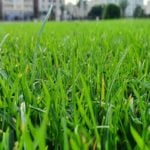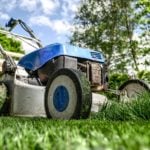So you want to put down fertilizer? Good choice, your lawn needs it! But if you aren’t careful, you could really mess up your lawn. From doing lawn care in Springfield and McLean, we’ve seen a lot of lawns, and have had to resuscitate a lot of damaged ones.
This guide will help educate you on the basics of Fertilization, and make sure you’re doing it right.
One of the most common lawn care mistakes made in the Northern Virginia area is applying fertilizer during inopportune times. Timing is very important when applying fertilizer and you first need to find out whether your lawn is warm or cool season grass.
Warm-season grasses such as St. Augustine or Bermuda thrive in warm temperatures. The best time to fertilize these types of grasses is during the months of April through August. Feeding the grass too early in the spring causes the nitrogen to promote rapid growth of weeds that thrive in the cool-season. If you wait until too late in the fall, the grass will not be fully healthy, causing it to more susceptible to winter injury.
Cool-season grasses are more common for Fairfax lawns and these grasses grow in the cooler seasons of Fall and Spring. This makes Fall and Spring the opportune time for fertilization. However, be wary of fertilizing too early in the Spring. This can lead to overly lush top growth and compromise the roots, which causes harm later in the year. The fall is when the roots that sustain the plants through the next summer are actively growing. Most fertilization for cool-season grasses should occur late August to November.
Fertilizing your lawn in the spring can encourage leaf growth, which also will harm root development. The fertilizer also feeds the weeds, which can lead to insect and disease problems later in the summer. If you put down fertilizer in the spring, try and keep it light (half-pound of 10-10-10 per 1000 sq ft.) once the initial growth in May has subsided.
Be very careful with fertilization during the summer. Most grasses in the Fairfax area are cool season grasses which tend to die back during the brutal heat we experience late in the summer.
Another important step often overlooked is testing the soil before applying fertilizer. Testing the soil can pinpoint exactly what your lawn needs, allowing you apply what is needed and keeps you from wasting money on nutrients it already has. You can have your soil tested by or pick your own kit from the Virginia Cooperative Extension.
The soil in Northern Virginia is naturally acidic and lime helps neutralize that. Therefore, lime is one the most common needs for lawn care in Northern Virginia. Keeping a balanced pH improves the availability of nutrients and can benefit soil microorganisms, which both add to the fertility and overall health of your lawn.
Finally, ask your lawn care provider to leave the mowing clippings on your yard. These grass clippings contain half of the nitrogen that your lawn requires, which is 2 pounds per 100 square feet. However, make sure these clippings stay on your lawn and don’t get blown down the storm drains, as they contain phosphorus that can be harmful to the watershed.





